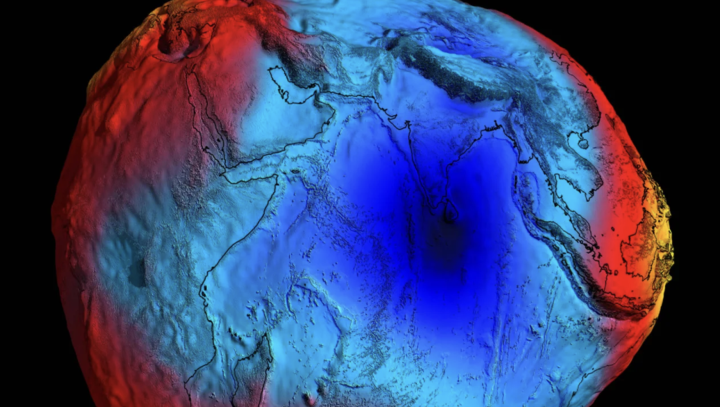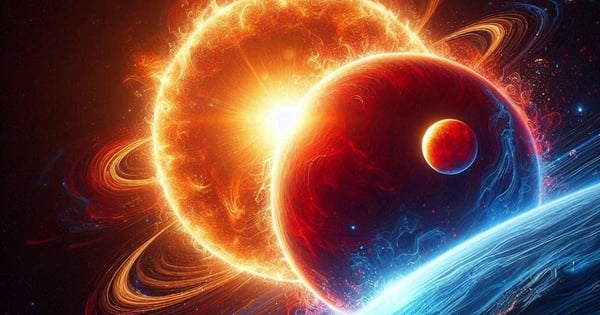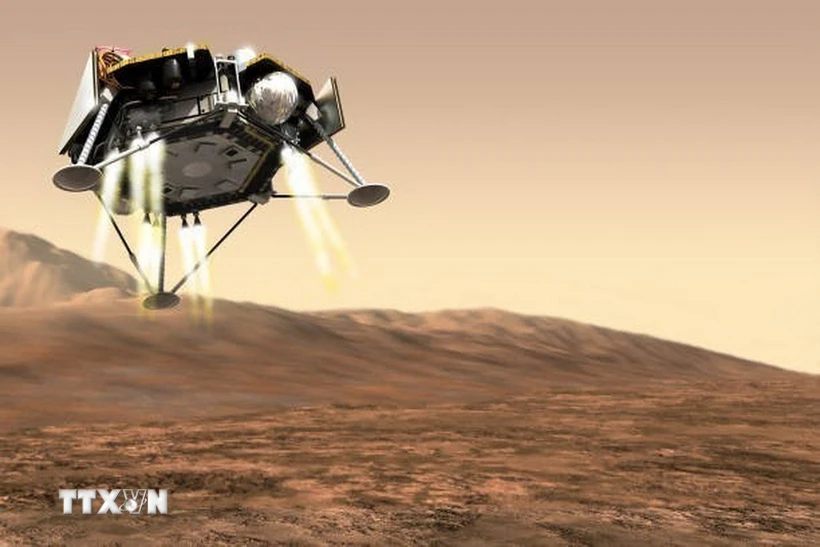Scientists have discovered a “gravity hole” in the Indian Ocean, where Earth's gravity is at its lowest, making everything there lighter than normal.
This anomaly has long puzzled geologists. Now, researchers from the Indian Institute of Science in Bengaluru, India, have found an explanation for how the hole formed: molten magma formed deep inside the planet was disturbed by the subducting plates of a former tectonic plate.
To come up with this hypothesis, the team used computers to simulate the formation of the region 140 million years ago. The findings, detailed in a study recently published in the journal Geophysical Research Letters , revolve around an ancient ocean that no longer exists.

Sea levels dropped more than 100 metres at a "gravity hole" first discovered in 1948, according to a new study. (Photo: ESA)
People often think of the Earth as a perfect sphere, but the reality is far from this. Neither the Earth nor its gravitational field are perfect spheres. Since gravity is proportional to mass, the shape of the planet's gravitational field depends on the distribution of mass within it.
“The Earth is basically a lumpy potato,” said study co-author Attreyee Ghosh, a geophysicist and associate professor at the Center for Earth Sciences at the Indian Institute of Science. “So technically it’s not a sphere, it’s an ellipse, because as the planet rotates, the middle bulges outward.”
Our planet is not uniform in its density and properties, with some areas being thicker than others - this significantly affects the Earth's surface and the Earth's different gravitational pull on these points. Imagine the Earth's surface being completely covered by a calm ocean, the variations in the planet's gravitational field could create bulges and valleys in this imaginary ocean.
Correspondingly, there will be areas of greater mass and areas of lesser mass. The resulting shape - called a geoid - appears to have small, irregular lumps like dough.
The lowest point on the Earth's geoid is a circular depression in the Indian Ocean, 105 m below mean sea level. This is the Earth's "gravity hole".
The starting point of the “gravity hole” in the Indian Ocean lies just off the southern tip of India and covers an area of about 3 million square kilometers. The existence of this hole was first discovered by Dutch geophysicist Felix Andries Vening Meinesz in 1948, during a gravity survey from a ship.
“It is the lowest point on Earth's geoid to date and it has not been properly explained,” said Ms. Ghosh.
To find out, Ghosh and her colleagues used a computer model to simulate the area as it was 140 million years ago to get a full picture of the geology. From that starting point, the team ran 19 simulations to the present day, recreating the movement of tectonic plates and changes in the mantle over the past 140 million years.
For each simulation, the team varied the parameters that influence the formation of magma plumes under the Indian Ocean mantle. They then compared the geoid shapes obtained from the different simulations with the actual geoid of Earth obtained from satellite observations.
Six of the 19 scenarios presented together concluded that a geoid low with a shape and amplitude similar to that in the Indian Ocean had formed. In each of these simulations, the Indian Ocean geoid low was surrounded by hot, low-density magma.
The magma plume, combined with the surrounding mantle structures, can account for the shape and low amplitude of the geoid, which is also the cause of the “gravity hole,” Ghosh explained.
Simulations were run with different magma density parameters. It is noteworthy that in simulations without plumes generated by the magma plume, the geoid low did not form.
The plumes themselves stem from the disappearance of an ancient ocean as the Indian Ocean drifted and eventually collided with Asia tens of millions of years ago, Ms. Ghosh said.
“The Indian Ocean was in a completely different position 140 million years ago, and there was an ocean between the Indian Ocean and Asian tectonic plates. The Indian Ocean then started moving north, causing this ocean to disappear and closing the gap between the Indian Ocean and Asia,” Ghosh explained.
When the Indian plate broke away from the supercontinent Gondwana to collide with the Eurasian plate, the Tethys plate that formed the ocean between the above plates was subducted into the mantle.
Over tens of millions of years, the Tethys Plate's seams sank into the mantle below, stirring up a hot magma pool beneath East Africa. This in turn fueled the formation of plumes, creating magma plumes that brought low-density material closer to Earth's surface.
However, Himangshu Paul, an expert at the National Geophysical Research Institute in India, notes that there is no clear seismic evidence that the simulated magma plumes are actually present under the Indian Ocean.
There are other unexplored factors behind the low geoid, he says, such as the exact location of the ancient Tethys ridges. “It’s impossible to mimic exactly what happens naturally in simulations,” he says.
New models show that the low geoid has more to do with the magma plume and reservoirs surrounding it than with any specific underlying structure, says Bernhard Steinberger at the German Research Center for Geosciences.
Phuong Thao (Source: CNN)
Useful
Emotion
Creative
Unique
Wrath
Source

































![[Photo] "Beauties" participate in the parade rehearsal at Bien Hoa airport](https://vstatic.vietnam.vn/vietnam/resource/IMAGE/2025/4/11/155502af3384431e918de0e2e585d13a)






























































Comment (0)